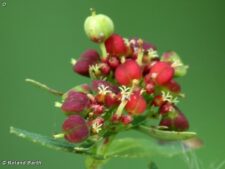
EYEBANE
Euphorbia nutans
SPURGE FAMILY (Euphorbiaceae)
 Identification
Identification
- Flowering time - July, August, September, October
- Uncommon in disturbed areas at FF and NW
- Erect plant with branching reddish stems
- Inconspicuous white flower with 4 petals
- Prominent, 3-lobed seed capsules, often red or with reddish tinge
This erect, native, annual grows up to 3 feet tall. The reddish stems (C) as well as the leaves contain milky juice. Oblong leaves are opposite and up to 1 inch long. The true flowers, which are invisible to the naked eye, lie within floral cups (cyathia). In the margin of the cup are 4 glands, each with a pinkish or white petal-like extension (B), responsible for the visible “flower.” A single 3-lobed seed capsule projects out of the cup (B). Capsules develop a reddish tinge or turn completely red as they mature (D).
This inconspicuous weedy plant is uncommon along trails and roadsides at Fontenelle Forest and Neale Woods. Flowering occurs from July through October.
The larger leaves and erect stem distinguish Eyebane from similar, but creeping, members of this genus. See account of Spotted Spurge (Euphorbia maculata).
Variable amounts of toxic chemicals (terpenes) are present in the milky sap of plants of the genus Euphorbia. Cases of livestock poisoning from hay containing eyebane have been reported.
The content of NatureSearch is provided by dedicated volunteer Naturalists of Fontenelle Forest who strive to provide the most accurate information available. Contributors of the images retain their copyrights. The point of contact for this page is: Neal Ratzlaff.



